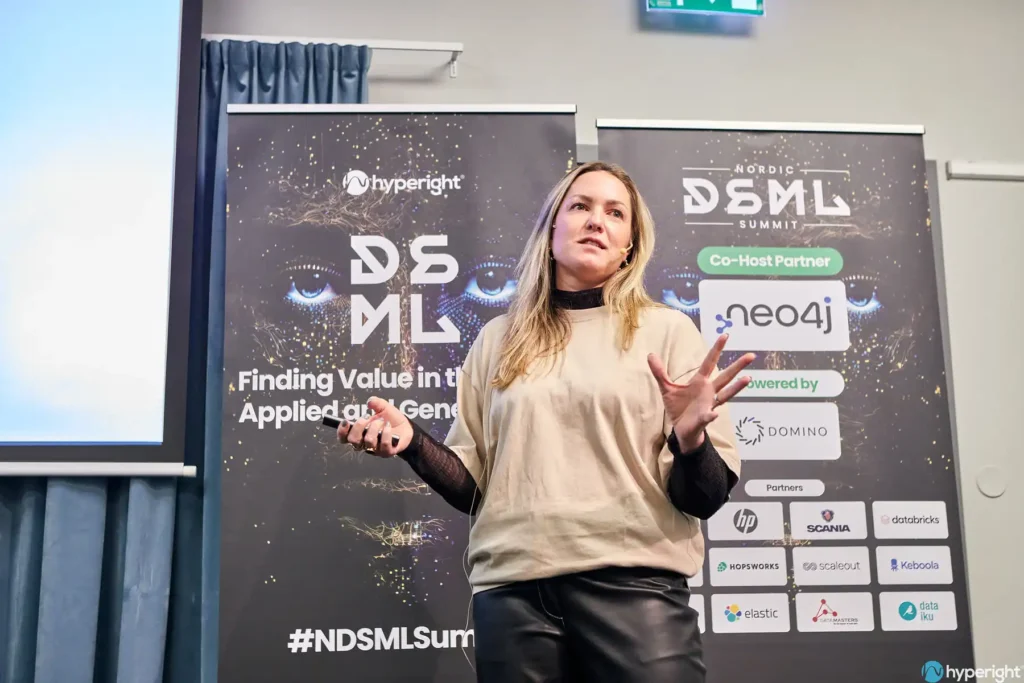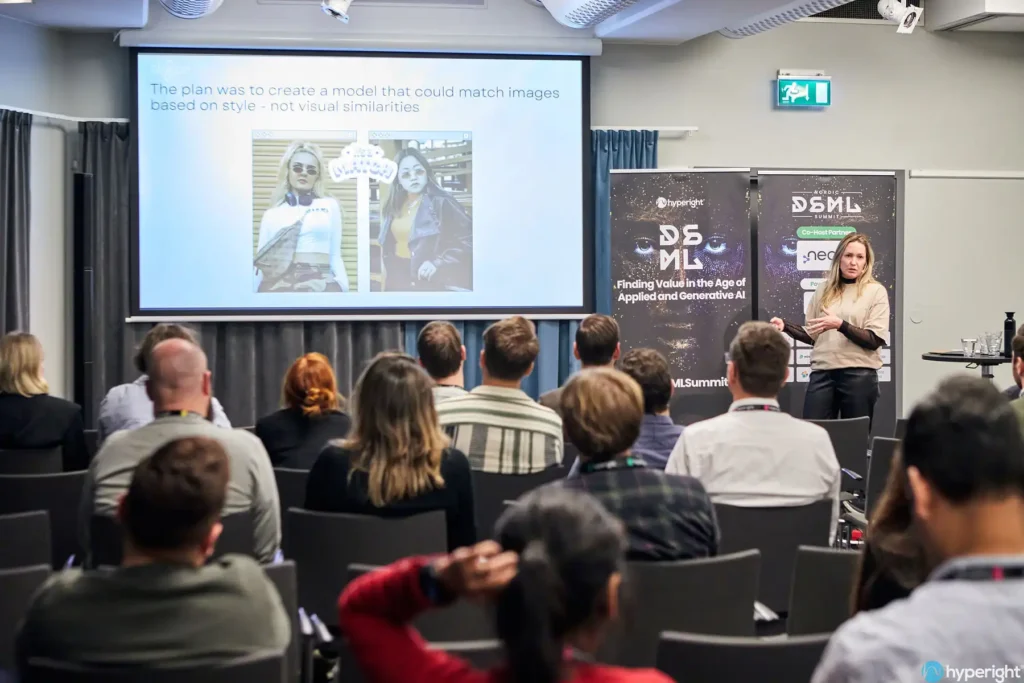In the fast-paced world of fashion, harnessing the power of data to deliver personalized recommendations is a desired goal. However, this industry aims to create a groundbreaking personal styling service using minimal data, envisioning a paradigm shift.
In the presentation ”Aim at perfection – and fail” at the Nordic Data Science and Machine Learning NDSML Summit 2023 in Stockholm, Sofie Perslow, CEO/CTO at Stylee Intelligence AB, presents a unique approach merging cutting-edge technology with style. This approach aims to establish a new standard of excellence within the fashion industry.
Stylee Intelligence AB is a new player in the fashion industry that aims to revolutionize clothing shopping by providing a personalized AI experience that helps customers find clothes they love and reduces returns for retailers. Stylee Intelligence AB leverages cutting-edge AI technology to understand unique style preferences and deliver personalized recommendations. This results in a more efficient and enjoyable shopping experience for both customers and retailers.
As a first mover using advanced image AI functionalities for personalized fashion recommendations, Stylee Intelligence AB aims to minimize data usage to solve problems in the fashion industry. The vision is to create a personal styling service, emphasizing the use of limited data as input for their AI model.


Stylee Intelligence: Unraveling the AI Model Behind Personalized Fashion
The AI model employed by Stylee Intelligence is designed to identify individual preferences and style choices, generating unique style profiles for both users and each item within the retailer’s assortment. This innovation unlocks the potential for a personalized and curated shopping experience for each customer in a totally new way.
”With a style profile as unique as your DNA, the experience exceeds the expectations of fashion enthusiasts, delivering an experience that aligns seamlessly with their unique preferences.” stated Sofie.
The Fusion of Creativity and Analysis in Fashion Elements
Encountering the notion that creativity and data couldn’t coexist, the company embarked on a mission to deconstruct creative elements in fashion. Beyond mere object recognition, the focus shifted to discerning intricate styles, pushing the boundaries of conventional image recognition. This analytical approach is transforming exploration into a fusion of artistic expression and data-driven insights.


Challenges for the Model
As Sofie, Founder and CEO of Stylee, explains, their work with AI was all about learning and adjusting as they went along. This experience made them rethink what they first thought and pushed them to try new things in digital styling. As is often the case with new technology, their journey was full of surprises and challenges. Furthermore, we’ll look at some of the main challenges they faced with their chosen AI model.
- Navigating the Approach: The AI model’s approach encompassed addressing a diverse range of objects through systematic sorting, a foundational solution to restore order. Despite the initial expectation of simplicity through image sorting and model training, the company soon confronted the nuances inherent in the process.
“Our perception of the ability to sort images based on single styles, or at least a limited amount of base styles was challenged quite quickly.” stated Sofie.
The company faced the challenge of dealing with unstructured, multi-layered images that lacked definition. The solution emerged in sorting data with multiple variables. However, this marked their second encounter; they wouldn’t attain perfection in sorting due to the complexity of the items.
- Categorization for Style Annotation in Image Representation: Initially assuming universal applicability in global frameworks for customer needs, the company envisioned a process where distinct styles could serve as a universal framework for data annotation. However, research revealed 11 distinct styles, prompting adjustments as they realized not all styles were equally relevant.
Acknowledging the ambiguity in image representation, the company omitted four styles, understanding that this compromise could potentially impact the model’s pursuit of perfection, introducing yet another challenge along the journey.
- Handling Extensive Datasets: The challenge of handling extensive datasets was significant, requiring the sorting of each image for model training. The company considered integrating cutting-edge technologies to revolutionize this approach, signaling a paradigm shift toward a more streamlined method for the next generation. Despite beginning with a modest number of images, the model’s training displayed promising results and good accuracy.
However, certain nodes needed refinement, prompting the targeting of each with tailored datasets for enhanced accuracy. This process wasn’t linear, emphasizing precision in style categorization. Despite diverse styles, the company aimed to identify similarities for effective sorting. However, confusion arose during model training, highlighting the complexity of achieving accurate style categorization.
- Borderline Cases: Borderline cases were another challenge, where the imperfection in the model was recognized. By establishing well-defined categories after sorting and discarding styles, the company had achieved clarity. However, noise and nuances in these systems disrupted their structure.
As we navigate the dynamic web landscape, trends continuously emerge, with Gen Z excelling at self-expression. Sofie noted, ”The nature of these trends could lead us astray, prompting a complete overhaul of our framework.” Despite this, they opted for a more measured approach and analyzed each style individually. By isolating one style at a time, patterns emerged, allowing them to understand the intricacies of the dynamics of the digital styling landscape.
- Navigating the Noise and Adapting to Trends: Rather than allowing the emerging styles to disrupt their framework, the company perceived them as a blend of existing styles. This enabled them to embrace the fluidity of fashion trends and ensure their system remained robust within the fashion landscape.


Validation and Future Prospects
Improving in accuracy and applicability for commercial use, retailers endorse the model’s practicality, and foster collaboration in the fashion industry. Enhancing understanding and communication, it signifies the impactful convergence of artificial intelligence and style, promising a bright future.
Key Learnings from the Journey:
- Prioritize privacy: Reimagine intelligent solutions with minimal data inputs, not trusting customer loyalty to help solve the urge for personalization.
- Harmonize data and creativity: Overcome skepticism by creatively dissecting fashion elements, demonstrating the relationship between data and creativity in fashion.
- Embrace iterative precision: Acknowledge and embrace the iterative nature of data-driven processes, understanding challenges in sorting and categorization as inherent steps toward precision.
- Navigate imperfection with flexibility: Acknowledge the non-linearity of data-driven processes, navigate complexities in borderline cases, and stay true to a framework while being adaptable to emerging trends.
In Summary
The journey of the fashion industry underscores the endless possibilities that arise when data, creativity, and technology converge. Looking toward the future, the fashion industry stands at the intersection of innovation and tradition, and this journey serves as a beacon for those navigating the uncharted territories of minimalistic AI in fashion.
Dive into the full presentation of unlocking fashion trends with a minimalistic AI model. Learn from more than 1000 practical case study videos with Hyperight Premium, and elevate your knowledge in the AI and data-driven world beyond limits.














Add comment